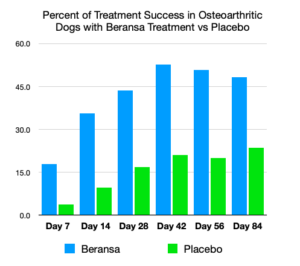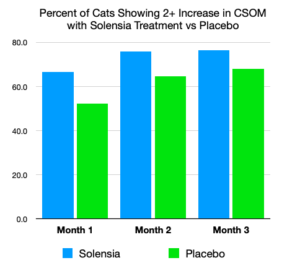Updated November 16, 2023 For many years, canine arthritis has lacked major breakthroughs, despite the tremendous need for better therapies. Now, in 2023 we are witnessing the appearance of a whole new class of treatment. These are exciting times,...
Updated November 16, 2023
For many years, canine arthritis has lacked major breakthroughs, despite the tremendous need for better therapies. Now, in 2023 we are witnessing the appearance of a whole new class of treatment.
These are exciting times, but we also need to be cautious. No treatment will work on every dog, and after initial overexcitement, some new products end up being major disappointments. However, with Beransa there is real hope for dogs that we have a new and effective tool to improve their quality of life.
What is Beransa?
Beransa is a trade name for bedinvetmab, also called Librela outside of Australia. It neutralises nerve growth factor (NGF), which has been shown to be involved in the perception of pain. As a monoclonal antibody, it has the potential to be highly specific to its target, and block it almost completely.
In Australia, Beransa has been registered for the alleviation of pain associated with osteoarthritis in dogs.
How Well Does It Work & How Quickly?
In our clinic, Beransa has quickly become the number one treatment chosen by our vets for new patients with arthritis. This has been based on a number of factors:
A very high success rate, interestingly higher than in the trial featured below Minimal to no observed side effects, especially compared with traditional anti-inflammatory drugs A similar cost to other treatments, especially in larger dogs
What does the evidence say? The results of a single placebo-controlled study conducted by the parent company are shown here and referenced below.
They show that around one in two dogs show benefit after a month. Like with all arthritis treatments, there is a large caregiver placebo effect, so it is important to stay as realistic as possible about its efficacy in each patient.
How To Use Beransa
Personally, I believe the study shown here and our clinical experience are enough to recommend trying Beransa in the right dog. However, I also strongly believe that we should not forget the other tried and trusted remedies for arthritis in dogs.
This is especially because Beransa only targets pain, not the underlying disease process. Now make no mistake: treating the pain is the most important thing, but it isn�t everything. If we add the treatments known to slow down the arthritic process, our dogs should have better function in the years to come as well as right now.
In particular, I encourage all dog owners using Beransa to at least continue the Hills j/d diet and regular pentosan injections. Both are extremely safe and can slow the degenerative process.
Beransa Dosage & Frequency
Beransa is given at a dose of 0.5 � 1 mg/kg by subcutaneous injection. It comes in a variety of vial sizes to cater for dogs of different weights. If desired, the dose is repeated every month. It is generally recommended to try at least two doses before deciding whether it is effective enough.
NGF is important for foetal and juvenile development. Therefore, Beransa must not be used in breeding, pregnant or lactating dogs, or those less than 12 months of age.
Human Health Risks
Similarly, pregnant women, women trying to conceive, and breastfeeding women should take extreme care to avoid accidental self injection or needle stick injuries. To be safe, it is best that they take no part in giving the injection or even holding their pet.
Just to be clear, a treated dog poses no risk to humans.
Beransa Side Effects
Reactions such as swelling and heat may occur at the site of injection, but these seem rare. Hypersensitivity reactions are also possible but appear more common in the cat form of this drug, Solensia.
Our experience with monoclonal antibodies like Cytopoint shows us that they are much safer than traditional drugs like anti-inflammatories. This is because as naturally occurring proteins, they require minimal metabolism or detoxification by the liver or kidneys. However, until there are studies of their use with liver or kidney disease, caution is still advisable in these dogs.
Beransa appears safe when used in combination with other drugs, and at the time of vaccination. The only concern with using multiple treatments could be that if an adverse effect occurs, you may not be able to identify the cause.
How Much Does Beransa Cost?
The cost in 2023 for a single injection of Beransa is between $100 and $130 depending on the size required. This is in the same region as the higher price anti-inflammatory drugs.
Beransa or Librela may not be a silver bullet, but just having another option is a great blessing. Our experience so far is that for some dogs, it maintains their quality of life when other choices fail. It can also be used when other treatments aren�t safe enough to use.
Anyone who has an arthritic dog knows that we still aren�t doing enough for them. The development of monoclonal antibodies brings us just one step closer, and just might give us more time to enjoy our lovely old dogs.
Therefore, talk to your vet about whether it might be good for your dog.
References
Corral, M. J., Moyaert, H., Fernandes, T., Escalada, M., Tena, J. K. S., Walters, R. R., & Stegemann, M. R. (2021). A prospective, randomized, blinded, placebo-controlled multisite clinical study of bedinvetmab, a canine monoclonal antibody targeting nerve growth factor, in dogs with osteoarthritis. Veterinary anaesthesia and analgesia, 48(6), 943-955 Full Text
Kronenberger, K. (2023). In dogs diagnosed with osteoarthritis, how safe and effective is long-term treatment with bedinvetmab in providing analgesia?. Veterinary Evidence, 8(1) Full Text
Have something to add? Comments (if open) will appear within 24 hours.
By Andrew Spanner BVSc(Hons) MVetStud, a vet in Adelaide, Australia. Meet his team here.










